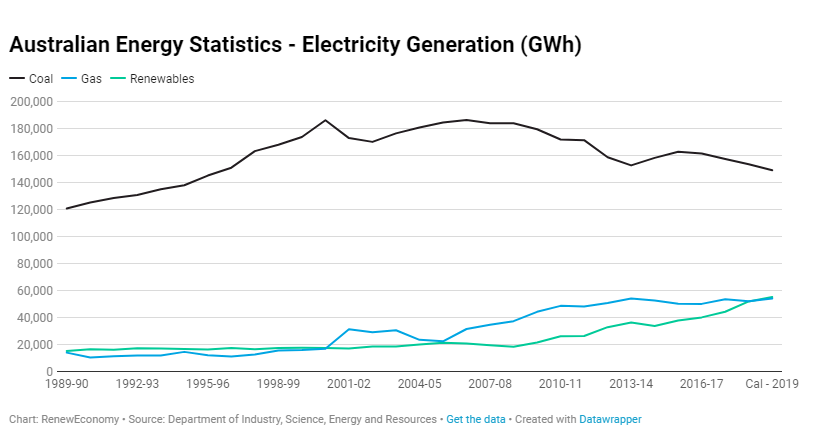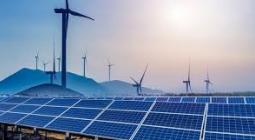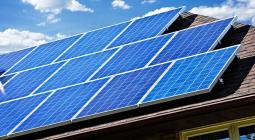Renewables share overtakes gas generation for first time, as coal falls to record low in 2019.

More electricity was produced from renewable energy sources Australia-wide than gas generation for the first time in 2019, as a surge in wind and solar generation also pushes the share of electricity generated from coal to an all-time low.
The milestones have been detailed in an early update to the official Australian Energy Statistics published by the federal government on Wednesday, with renewable sources providing a combined 21 per cent of electricity generation in 2019.
This saw the combined market share of renewable energy sources, including wind, hydro, solar and bioenergy surpass gas generation for the first time, with gas supplying 20.5 per cent of Australia’s electricity use last year.
Both wind and solar generation overtook hydroelectricity in 2019 to become Australia’s largest and second-largest sources of renewable electricity generation, respectively. Wind and solar generation have been the fastest-growing sources of electricity supplies in Australia over the last decade, with coal experiencing a multi-decade decline as older coal generators begin to exit the market.
Wind generation supplied 7.4 per cent of Australia’s electricity, compared to 5.4 per cent from hydro. The amount of electricity supplied from solar, from both large and small systems, reached 6.8 per cent in 2019.
The share of Australia’s electricity produced by coal fell below 60 per cent in 2019, with black coal generating 43.9 per cent of Australia’s power, and brown coal providing falling to 12.5 per cent. This is down from a historic high of almost 84 per cent achieved in the late 1990s.
The peak for coal generation has well and truly passed, and has virtually been completely displaced by lower cost sources of wind and solar generation. This was very visibly apparent with the demolition of eight smoke stacks at the now closed Hazelwood power station earlier this week.

Generation from gas remained has remained relatively stable, representing 20.5 per cent of Australia’s supplies in 2019 and was consistent with its average market share over the last five years.
Despite the clear trends in the statistics, federal energy minister Angus Taylor said that the data showed coal remained “essential” and that the increases in renewable generation were being “backed by gas”.
“Australia continues to be a world-leader in renewable energy, with ongoing increases in renewable capacity and generation”, Taylor said.
“This latest data also demonstrates the continuing importance of coal and the significant and growing reliance on gas to back our significant renewable capacity.
“Gas is flexible and provides the dispatchable capacity we increasingly need to balance intermittent renewables and deliver a secure, reliable and affordable electricity system to power our homes, businesses and industries.”
An earlier estimate published by the Clean Energy Regulator found that around 6,300MW of new renewable energy generation was added in 2019, but there are wide expectations within the industry that investment will be subdued going forward, due to uncertain federal policies and ongoing grid connection difficulties.

Taylor added that the statistics underpinned the need for a ‘gas led economic recovery’, despite gas generation remaining relatively flat over the last decade, while renewables have surged.
“This is why the Australian Government believes a gas-fired recovery will drive jobs and economic growth,” Taylor added.
“We now need state and territory governments to do their part to unlock more gas for the domestic market and encourage investment in reliable generation which will put downward pressure on wholesale prices.”
Opposition climate change spokesperson Mark Butler has criticised the government’s focus on the gas sector, noting that it has done little to supply the domestic market, and contributed little to lowering energy prices.
“We now need state and territory governments to do their part to unlock more gas for the domestic market and encourage investment in reliable generation which will put downward pressure on wholesale prices.”
Opposition climate change spokesperson Mark Butler has criticised the government’s focus on the gas sector, noting that it has done little to supply the domestic market, and contributed little to lowering energy prices.
“What has happened to the Eastern state’s gas market will provide rich material for many, PhDs over the coming years. It really is one of the most abject failures of public policy over the last 20 years,” Butler told an online conference organised by the Carbon Markets Institute last week.
“So the idea that we would go back for more, and ground economic recovery on a fossil fuel that is the subject of a fundamentally dysfunctional market, where prices have tripled and supply for domestic businesses and households is scarce, doesn’t doesn’t have much attraction to me.”

The official statistics include figures for States covered by the National Electricity Market, as well as Western Australia and the Northern Territory.
The statistics are also able to capture data on self-generation use, including behind-the-meter generation from businesses and households.
Tasmania led the States with the highest proportion of electricity sourced from renewables, due to the state’s large hydroelectricity scheme helping it record 94 per cent renewables in 2019.
South Australia came in second, crossing over the 50 per cent renewables threshold for the first time in 2019, followed by Victoria at 21.2 per cent and New South Wales with 18.7 per cent.
Queensland recorded the highest growth in 2019, with the share of renewables jumping from 8.9 per cent to 13.2 per cent.
Western Australia reached 10 per cent renewables, while the Northern Territory sourced 4.1 per cent of its power from renewables, predominantly solar. Many rural and remote parts of both Western Australia and the Northern Territory remain reliant on generators using liquid fuels, like diesel.
Overall electricity demand increased for the fifth straight year in 2019, recording a slight increase of 0.78 per cent over the previous year.
RenewEconomy and its sister sites One Step Off The Grid and The Driven will continue to publish throughout the Covid-19 crisis, posting good news about technology and project development, and holding government, regulators and business to account. But as the conference market evaporates, and some advertisers pull in their budgets, readers can help by making a voluntary donation here to help ensure we can continue to offer the service free of charge and to as wide an audience as possible. Thank you for your support.
27 May 2020
RENEW ECONOMY




